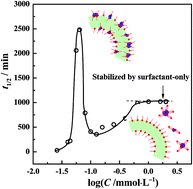Highly stable aqueous foams generated by fumed silica particles hydrophobised in situ with a quaternary ammonium gemini surfactant†
Abstract
Commercially available fumed silica (F-SiO2) was hydrophobised in situ via the interaction with a cationic gemini surfactant, ethanediyl-α,ω-bis(tetradecyldimethyl-ammonium bromide) (14-2-14), in aqueous solution. The effect of this surfactant modification was far higher that carried out by its corresponding monomer, tetradecyltrimethylammonium bromide (C14TABr). The mechanism of modification was assumed according to zeta potential measurements and observations of physical appearance. These particles were used to generate and stabilize aqueous foams. Both the foaming efficiency and the stabilising ability of F-SiO2/14-2-14 all exceeded that of F-SiO2/C14TAB. In the gemini case, the synergism and competition between the particles and the free surfactant molecules for their adsorption at the foam film were found, which resulted in two peaks in the foam stability curve. Dilational rheology of the films was measured using an oscillating drop technique. There were also two maxima in the dilational elasticity ε for the F-SiO2/14-2-14 system, respectively corresponding to each maximum in foam stability.


 Please wait while we load your content...
Please wait while we load your content...